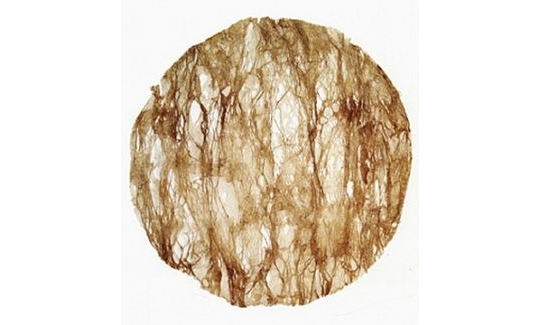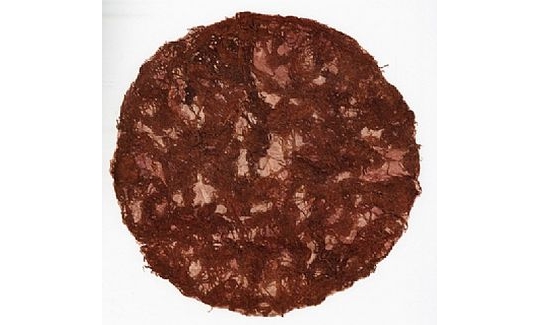"Kami" (Japanese paper) is a group exhibition of contemporary Japanese paper art. The artists are: Asakura Syunsuke (b.1957), Iwamura Shinichi, Yamashita Fusae, Naito Kinuko (b.1970), and Shimakawa Yasuhiro (b.1964). Most of them live in the Imadate region of Fukui Province, renowned for its flourishing paper industry.
Paper originated in China in 105 CE. It was originally prepared from fibres of the hemp shrub (cannabis) or the kozo tree - the paper mulberry. In the year 610 paper appeared in Korea whence it reached Japan. The Japanese initially used the bark of the kozo, but soon discovered that paper could be prepared from other vegetation such as the bay (gampi) and Edgeworthia papyrifera (mitsumata) trees. Since that time, Japanese paper has been known as "washi". There are many districts of Japan where washi is made, and the type of paper produced is specific to each of them. Paper from Fukui Province is known as Echizen washi.
A local legend relates that 1500 years ago, a beautiful princess named Kawakumi-gozen appeared by the Okamoto River, near Imadate.. She taught the local inhabitants how to make paper. This princess was the goddess of paper, and she founded the paper industry that flourishes there to this day. To preserve the tradition, the "Avenue of the Paper Village" (washi no sato dori) was created, with papermaking studios and museums demonstrating the process of making Echizen washi. Historic documents and the first paper money were made there in the second half of the 17th century, and there are also exhibitions of works by contemporary Japanese paper artists.
In the past, most of the paper artisans were farmers who grew the cannabis and kozo in addition to their regular crops. Preparing paper was their seasonal occupation, usually in winter when they could not work in the fields. In the Meiji era (mid-19th century) there was an increased demand for paper in Japan, and industrial paper was imported from the west. This did not detract from the ongoing traditional manufacture, because high quality paper is always hand-made.
To prepare paper the fibres are first stripped from the bark. They are then boiled, steamed, pounded, and then rinsed in distilled water. This bast thinned with water is transferred to a large vat. A wooden form with a fine mesh stretched across it is moved back and forth through the water. Small shreds of the bast adhere to the mesh, forming a solid layer. The form is then removed from the vat and strained. After a process of draining and drying in the sun, a sheet of paper is thus produced. The paper is often embellished by the addition of various other natural fibres or bark during the production process. It is possible to place a stencil over the wooden form in order to create varying thicknesses, or to impress the paper with a metal stamp during the drying process. Hand-painted, woodblock printed, and stencilled papers are also made.
The word "kami" has several meanings in Japan. The Shinto deities, for instance, are kami, and even though the words for "deity" and "paper" are written with different Chinese ideograms, they sound the same. Perhaps this relates to the sanctity of paper in Japan. The whiteness of paper expresses purity in the Shinto faith to this day. White paper decorations (gohei) are hung at the entrance to Shinto shrines, indicating the presence of the deity and the sanctity of the place.
In Japan, traditional hand-made paper is still used for various purposes - paintings and prints, stencils for illustrations (katazome), origami (the art of paper folding), for domestic articles such as sliding panels, lampshades; in industry as wrapping material; for personal items such as fans; for playthings such as dolls and kites.
Japanese artists of today excel in their use of traditional paper as both medium and subject in works that have no function other than artistry, including paper installations, paper sculpture, abstract 2-dimensional paper works, etc. Even though they also use other types of paper, including newsprint, it seems that the artists' preference for kami - as material and subject - confirms the reverence with which it is regarded in Japan.
Although the contemporary artists preserve the natural character of the paper in their works, it must be remembered that this material is fragile. Their choice of it perhaps derives from the ancient belief that began in the 12th century. When spring arrives, and preparations are made for planting the rice, the farmers cast paper dolls into the rivers to carry away with them all diseases and misfortune. Perhaps the artists have adopted the Buddhist concept of the wheel of life and death in a transient world. The works of Asakura Syunsuke, who creates natural forms, sometimes seem to be made of some stiff material, while others of his works give precedence to the eternal embodied in the transient. From the works of Naito Kinuko emerge letters, calligraphy on the paper that seems to melt back into it, like the cycle of life and death. The works of Shimakawa Yasuhiro undergo a process of folding, painting, and unfolding, also preserving the notion of transience. Iwamura Shinichi makes window-like shapes against a background of different textures, while Yamashita Fusae presents reliefs with alternating black and white diagonal stripes - again like the cycle of nature.
Acknowledgements:
The exhibition is presented by courtesy of the Japan Foundation and the Japanese Embassy in Israel.


